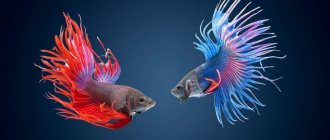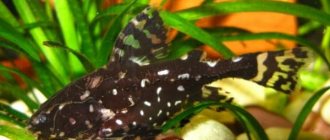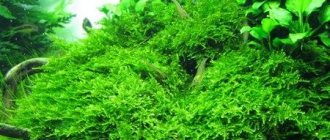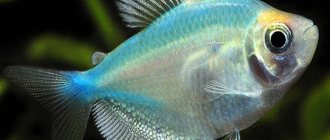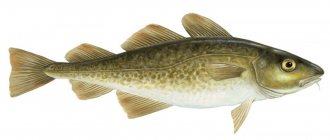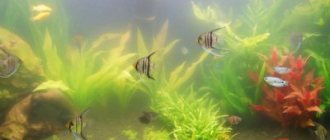Premature introduction of fish into a new aquarium
Most often, this mistake is made due to the fact that you want to get the fish into the aquarium as quickly as possible.
The water poured into the new aquarium has reached room temperature, and the fish are immediately sent there. You can't do that! Take your time, otherwise you will only make things worse. First, you need to rinse the new aquarium very well with soda and salt (for best results, let it sit in the water for about one day, periodically changing the water from time to time). This is necessary in order to get rid of all the harmful chemicals contained in the putty that covers the glass of the aquarium. But even after this, fish should not be allowed into the aquarium. Wait a little longer.
First you need to place the soil in the aquarium and plant plants in it. After a few days, add snails, and a day later, if you really want, you can add a couple of guppies, but the aquarium should be completely populated at least 2 weeks after filling it with water.
IMPORTANT! Under no circumstances should you introduce fish into the aquarium immediately after filling it with water!
Remember this. Otherwise, all your work, and even your money, will go down the drain - the fish will get sick, the plants will look sickly, and, yes, it’s possible that there will be algae, which will be very difficult to get rid of.
Goldfish in a 20 liter round aquarium
Many beginners decide to place goldfish, or any of its derivatives, in a small, round 20 liter aquarium. Goldfish and their relatives feel better in large, spacious aquariums.
Also, these fish eat a lot, and they eat not only food, but all living plants that fit in their mouth. Goldfish also love to chew the beautiful fins of their long-finned relatives, such as orandas or comets. Moreover, goldfish dig up the soil all the time. Keep this in mind when you get these sweet beauties.
REFERENCE! Such fish are not very suitable for beginners, and before getting them and placing them in your aquariums, it is better to practice on simpler types of fish, such as guppies and zebrafish.
Akara
Dangerous for plants and small fish. Keeping in a school or solitary.
Ancistrus
Lives alone. Sometimes Ancistrus competes with bottom dwellers for territory.
Apistogram
Aggressive during spawning. It settles alone or in a group of a male and 2–3 females.
Astronotus
Calm view. Compatible with fish of comparable sizes. Do not place with small fish, such as guppies and neons. Astronotuses perceive them exclusively as food. Plants are destroyed. Content alone or in a group.
Barbus
A gregarious and active species. Fins are bitten off.
Bocia
Compatible in an aquarium with peaceful fish of comparable sizes. They bite the fins. They live in a flock of 5–6 individuals.
Guppy
Active and friendly appearance. Guppies are compatible with small fish of similar temperament. Keeping in a school or solitary.
Gourami
Poses a threat to small neighbors. Gouramis live alone, in pairs or in groups. They eat plants.
Danio
Mobile and peaceful fish. They live with non-conflict playful neighbors. School look.
Discus
Compatible with non-aggressive large fish. Keep discus in a flock of at least 6 individuals.
gold fish
Compatible with peaceful cohabitants. Lives in a flock or alone. Digs up plants.
Cardinal
Calm and peaceful. Gets along with neighbors of similar size and character. Lives in a flock of 10 or more.
Carnigella
Peaceful and shy. Lives in a flock of 6 individuals, prefers proximity to related species.
Koi carp
Get along with other koi and goldfish.
Congo
Compatibility with peaceful and medium-sized water inhabitants. Pack living.
Labeo
Leads a solitary lifestyle. Clashes with others occur when there is not enough space.
Lyalius
Peaceful and calm. It is unacceptable to keep with fish that bite off fins. Gets along with neighbors of similar size and temperament. Lives alone or in a harem of one male and 2–3 females.
Macropod
Males are aggressive. They inhabit singly or one male for several females.
Melanochromis
A relatively peaceful cichlid. Intolerant during spawning. Melanochromis auratus is dangerous for plants and small fish.
Swordtails
Active, peaceful. Compatible with non-aggressive neighbors of similar size. Accommodation alone or in a group.
Mollies
Peaceful and mobile. Compatible with aquarium pets of the same temperament.
Neon
Friendly and playful, they keep in flocks.
Nothobranchus
Clashes occur between males. Place at least two females per male.
Paku
Quiet and shy. They live in groups and alone. Damage plants.
Ornathus
Fixed and tolerant fish. Lives in a flock of 6 individuals.
Cockerel
Compatible with non-aggressive species of similar size. Keeping solitary or in a group of a male and several females.
Pecilia
Peaceful livebearer. Compatible with many types. They live in a flock together with other livebearers, but can also live alone.
Piranha
Suitable for single living. Intolerant of other species and neighbors.
Parrot
Calm and peaceful cichlid. Compatibility with the same leisurely and non-aggressive creatures.
Pristella
Playful, compatible with similar small fish. Pack living.
Pseudotropheus
Unfriendly with others. Compatibility with non-conflict neighbors is possible. They react aggressively to blue and yellow colors in other fish. They inhabit in the ratio of one male to 2–3 females.
Rainbow
Active and peaceful, compatible with fish of similar temperament and size. Living in a flock of 6 or more rainbows.
Rasbory
Friendly small fish successfully coexist with comparable species. They live in flocks of 8 individuals.
Splashfish
Peaceful and calm inhabitant of the reservoir. Dangerous for too small neighbors. Inhabits a group of 4–5 individuals.
Angelfish
A leisurely and peaceful cichlid. Compatible with non-conflict indifferent fish. There should be at least 4 angelfish in one aquarium.
Catfish tarakatum
This peaceful aquarium cleaner is compatible with many fish, including aggressive ones. Aggression is possible during spawning.
Speckled catfish
Compatible with suitable sized aquarium fish species. Feels comfortable in a group of 3 or more individuals.
Ternetia
Active, peaceful. Pack living.
Tetra
Active, friendly fish. Gets along with equally active neighbors of similar sizes. A flock contains at least 5 individuals.
Tropheus
Aggressive towards neighbors of its own and other species. Single existence is allowed.
Philomena
Active and flocking neighbors. They will become a nuisance for slow and quiet neighbors.
Flashlight
A peaceful, playful fish kept in a school.
Chromis
Aggressive during the spawning period. They live in pairs. They bite plants.
Cichlazoma
Tolerant of neighbors. Aggression occurs within a species between males. They live in pairs and alone.
Wrong selection of fish in the aquarium
This point is similar to the previous one, but there will be more exotic fish that are sold by kids at markets.
Yes, these kids are quite cute when they are little, but they grow up and become much bigger and angrier, and begin to attack those who are smaller than themselves. After six months, the owners begin to panic and look for where to send their monsters, which feed on other fish and take up all the free space in the aquarium. Typically, such fish are various catfish, piranhas, pterygoplichts, and large cichlids.
Therefore, watch what you buy at the bazaars, do not take what the seller is trying to squeeze into you. And already at home, using the Internet, look for information about those fish that you would like to see in your aquarium, read about their content and about which fish they can be friends with and which ones should not be housed with. And only after you know everything, you can go and buy fish.
Overpopulation in the aquarium
This mistake is made very often!
It’s unlikely that you would like living in a small apartment where two dozen other people will live with you. The fish don't like it either. You need to think carefully before buying a huge pile of fish, because this pile will definitely not look good in your aquarium. And even more so when they grow up and breed. A little is better, but with taste. Excess has always been considered bad manners. But you want to have a beautiful aquarium that all your relatives and friends would admire.
Overfeeding fish
Well, everything is simple and clear here - it is better to underfeed than to overfeed. For adult fish, normal feeding is considered to be feeding twice a day - morning and evening. However, the portions should not be very large. A few bloodworm larvae, either live or frozen, or several live tubifex worms, the size of a match head, are enough for each fish. If you feed the fish with dry food, then you need to sprinkle it by eye, but so that the portion is eaten in no more than five minutes. If you overfeed the fish, the food may fall down onto the ground, get into it (if the food is alive), and spoil the water.
Young fish need to be fed more often - from three to five times a day, in small portions and a varied menu. It is necessary to ensure that the fish do not eat too much and do not fill themselves to satiety. It is best to feed them a little, but more often.
How to populate incompatible species
Fish with different habitat requirements are not housed together. It is possible to introduce fish with different personalities. For a successful neighborhood, follow the rules:
Even full compliance with these rules does not guarantee that there will be no clashes between the inhabitants of the aquarium.
Turning off aquarium equipment at night
Many people believe that the aquarium must be turned off at night. This is wrong! You don’t turn off the air conditioner in the heat while closing the windows. Never, under any circumstances, turn off filters with a compressor at night. If you don't like the hum of the compressor, you can use an internal filter instead.
It is worth noting that the compressor (if, of course, it is of high quality) does not make much noise, and almost all filter pumps are completely silent. You just need to turn off the special function of pumping air bubbles from the outlet in the filter, and direct the stream of water that comes out of it to the surface of the water. Thus, the compressor will no longer be needed at all, because the water will be ideally enriched with oxygen.
But if there are a lot of fish in the aquarium, you will still have to install a compressor. Therefore, before placing an aquarium in your home, you need to think carefully and start choosing the appropriate equipment for it.
Compatibility table for aquarium fish in one aquarium
Find out the compatibility of the aquarium fish you are interested in at the intersection of the names in the table. With full compatibility between cohabitants, clashes are excluded. Limited compatibility indicates the need of neighbors for a voluminous aquarium with shelters. Residents with conditional compatibility require supervision. Do not place completely incompatible fish in the same container.
No water replacement
Here is another common mistake made by novice aquarists. Many of them do not know at all how to clean an aquarium, and some are not aware of it at all. Since waste accumulates in the aquarium, it must be constantly removed with a siphon and the water changed. The fish, of course, will not die from irregular cleaning, but it will still have a negative impact on them. The fish will be subject to very strong stress, because they are not accustomed to such poor conditions, which means they may get sick and will not live very long.
Compatibility Principles
Wrong choice of soil and plants
When choosing soil, you need to follow only one important rule: the finer the substrate, the better it will be (small pebbles or sand are perfect). Coarse river sand is best suited, as it is ideal for establishing biological balance. But you can buy small pebbles at a regular pet store, which will be slightly smaller in size than a seed. Such stones can perfectly replace river sand.
But it is better not to use colored pebbles . They may be beautiful, but this is only at first, before the paint washes off. When this happens, the stones will turn white and completely ugly. White soil is of course good, but it will reflect the light of the lamp and take all the attention to itself, and this is what the fish should do.
What about plants? What to give preference to - artificial or live algae? Everything is easy here too. If you are a lazy person, choose artificial ones, because they require almost no maintenance. They only need to be washed and cleaned once every six months (although more frequent care will not hurt). And the choice of artificial algae is simply huge! You can choose forever - by shape, by color, by size, etc. But if you want to see living vegetation in your aquarium, then get ready for the fact that you will have to constantly care for the plants and devote a lot of time to maintaining it so that it all looks amazing.
The main mistakes of beginner aquarists
Newly acquired fish are not subject to quarantine.
Many hobbyists do not quarantine new fish and place them in a community aquarium. In no case! Unfortunately, very often the fish sold have infectious diseases, which cannot always be determined at the time of purchase, because... Diagnosis of many diseases in the early stages is not always possible. This can cause infection and death of all your fish. Don't buy fish from dubious companies
sellers, observe how the fish behave in the aquarium where they are sold. Never buy fish if you see dead fish. It is increasingly rare in Vladivostok to buy fish that are bred by amateurs; fish from China and Southeast Asia that has not undergone high-quality quarantine is increasingly being sold (even at the Lugovsk market). Place the newly acquired fish in a separate aquarium (equipped with aeration, without soil and plants, filled with water from your aquarium, where the fish will live in the future). If the fish look healthy within two weeks, feel free to add them to the community aquarium.
Insufficient water filtration
The aquarium filter must pass through all the water in the aquarium at least 3 times per hour. If it doesn't do this, then you don't have adequate filtering. If you have doubts about the filter size, it is better to take one size larger. You can't overfilter, but you can definitely underfilter and the results will be harmful to your fish.
The aquarium is lit too much or for too long during the day.
One of the common mistakes beginner aquarists make is leaving the aquarium light on for too long during the day. This is especially true for aquariums that are located in places where people are around the clock - clubs, restaurants, etc. When there is a lot of light in the aquarium, uncontrolled algae growth is guaranteed! Even if your aquarium contains live plants, you should not keep the lighting on for more than 10 hours a day. The time can be reduced to 8 hours if you use bright lamps. Do not expose the aquarium to direct sunlight. If there are no live plants, lighting time can be reduced to a minimum - you need the light, not the fish. I recommend using a timer to turn the aquarium light on and off.
No water replacement
On the contrary, people who have just purchased and installed an aquarium are not always aware of how to clean their aquarium, which includes regular partial water changes. Waste accumulates in the aquarium, which can only be removed with a siphon, as well as by replacing some of the water with fresh water. Even though your fish won't die if you don't do this regularly, they will still be stressed by unusual water conditions. As a result, the fish will be more susceptible to disease and their life cycle will be shorter.
Wrong choice of soil and plants
When choosing a substrate, you can be guided by only one main rule: the finer the soil, the better (small pebbles or sand). Practice has shown that coarse river sand is best suited for establishing a stable biological balance in an aquarium, but it is easier to purchase small stones at the pet store, no larger than a seed, and the effect is no worse than sand.
You should not buy multi-colored pebbles in the store. It is possible that you will say: “They are so beautiful!”, But this is only at first... the paint will peel off over time. The pebbles will turn from colorful and bright to white and unsightly. It would seem that white soil is not bad either, but it will attract too much attention to itself, reflecting the light of the lamp, but you want the fish to attract attention.
Let's move on to plants. Which one to choose - artificial or live algae? I will say one thing, if you are a lazy person like me, then take unnatural ones, because... they require virtually no maintenance, except for washing and cleaning once every six months (more often), and the selection of such algae in pet stores is simply huge. Both in color and shape - for every taste. If you prefer live flora in the aquarium, then you will have to constantly make a lot of effort to ensure that it all looks beautiful and tasteful.
Danger brought from outside
Of course, a gap may appear in the established balance of the aquarium if the basic rules of “sanitation” are not followed. When purchasing new “neighbors” for your fish, you should take the health status of the newcomers seriously. Not on the device
Look for fish with suspicious formations on the body, wounds, or “bitten” fins. Otherwise, along with the new residents, you can introduce infection into the aquarium.
The fish must be healthy. You can assess its condition by its appearance; if the dorsal, anal fins and tail are compressed, this indicates poor health. The fins should be straightened. A healthy fish behaves actively, reacts to movements made by the owner (move your hand over the aquarium - the fish should ask to eat, vigorously swimming back and forth).
When purchasing new artificial algae or decorations, they must first be kept in water for two days. Then you should pour boiling water over the new item, cool it, wash it with laundry soap, rinse it well, and only then install it in the aquarium.
And finally, the last reason for the appearance of infection is food. Dry food is quite safe, but together with live and frozen food, you can introduce various parasitic organisms, as well as some diseases, into the aquarium. Therefore, feed of this type can be used extremely rarely. For example, I use live food only to “raise” a fish that has suffered from some kind of illness. But this should be done very carefully, washing the food well before “serving”.
In this article, I tried to point out as accurately as possible the main problems of novice aquarists. At one time I also encountered them. He learned from his mistakes, at the cost of the lives of many of the inhabitants of the aquarium.
If you are ready to face the obstacles that you will have to overcome sooner or later to achieve success in the aquarium hobby, and are not afraid of failure, then go ahead! Learn from other people's mistakes! In this case, on my...
Conclusion
In conclusion, we would like to say that we console ourselves with a very weak hope that novice aquarists will take advantage of our advice. Therefore, the well-known principle “we wanted the best, but it turned out as always” will almost certainly prevail. But still, somewhere in the depths of our souls, we hope that the next newcomer, after reading our article, will draw at least some small conclusions from the mistakes of others.
And although real life proves every time that even direct and absolutely correct instructions are completely ignored by novice aquarists, allow us to make one more attempt to set you on the right path. Good luck!
THE BEST CORAL REEFS IN THE WORLD
HOW TO CHOOSE AN AQUARIUM FOR YOUR HOME: DESCRIPTION, PHOTO
AQUARIUM - DIVISION OF AQUARIUMS BY PURPOSE
BEST AQUARIUM SIZE FOR BEGINNERS - SMALL OR LARGE AQUARIUM?
Newly acquired fish are not subject to quarantine
Many beginners do not know that new, newly purchased fish must be quarantined, and they are released into a community aquarium. This should not be done under any circumstances. Very often it turns out that newly purchased fish are carriers of various infectious diseases and at the time of purchase they are sometimes impossible to identify. When they are placed in a community aquarium, these diseases are transmitted to other fish, causing them to get sick and may even die.
Important! You should not buy fish from sellers you doubt.
When you come to the store, carefully observe the behavior of the fish in the aquarium. If there are dead fish in it, do not buy fish from this place. Fish from China and Asia are being sold more and more often. Unfortunately, this fish does not undergo high-quality quarantine. Therefore, when you buy your fish, place them in a separate, empty aquarium that contains the same water as the main aquarium. Keep the fish there for a couple of weeks and if they look healthy, you can put them in a community aquarium.
Water parameters are not tested
Before adding fish to the aquarium, you need to make sure that all water parameters meet the basic criteria and the water is quite suitable for keeping fish. There are special kits sold in absolutely any pet store. These kits are designed to test the water in your aquarium. Be sure to test the water for the presence of nitrates, pH, nitrites and carbonate hardness.
You can find the ideal values for these indicators on the Internet. For a week, do these tests every day. If the indicators correspond to the norm and do not change, the fish can be stocked. This should be done gradually, and there is no need to populate all the fish at once. After moving in, conduct tests every week. If the indicators do not correspond to the norm, use special preparations that will help adjust the water to the ideal. If you have any difficulties with testing, call a professional. He will definitely help you solve all your problems.

